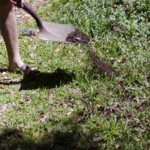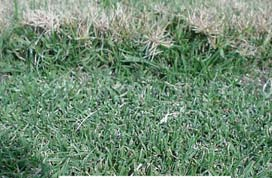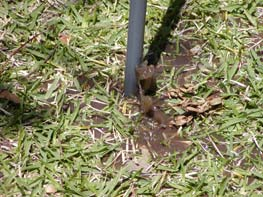Lawns can seem difficult to keep healthy in our hot, drought-prone summers and alkaline, easily compacted heavy clay soils. There are some simple lawn care steps that boost health and avoid the problems with diseases and pests.
Improve Lawn Health with Soil
Lawns need 4”-6” of well-drained, organic-rich soil for the roots to be able to access oxygen, moisture and nutrients. Compacted clay soils do not have good air flow, and can prevent water from soaking down to the roots. Conversely these same soils can hold moisture at the roots for too long once it does finally soak in. Organic matter in the soil breaks up the clay lumps, allows air and water to flow, and feeds beneficial microorganisms.

Let the grass poke through the compost
Before you seed or sod turfgrass, till compost or a good garden soil into the native soil. You will be able to feel the difference right away. Apply compost annually as a thin top dressing to establish lawns. Rake it in to let the grass grow up through it.
Choose the Right Turfgrass for Your Site
Each of the four turfgrasses for our area have widely different growing needs. For shade, you will need St. Augustinegrass. Zoysiagrass is best for combinations of sun and very light shade. Bermudagrass or buffalograss grow in full sun and are drought tolerant, but only bermudagrass will tolerate a lot of walking on it. If you want a low-mown grass, go with bermudagrass, if you want a grass that needs no maintenance once established, try buffalograss. If you have the right grass in the right spot, you will have a lawn that thrives, but if you try to grow grass in conditions it does not like, then it will always look stressed.
Mow the Right Height
St. Augustinegrass is a shade grass with long, wide blades that you should cut at about 3.5” in height. That means you let it grow to 4” and cut it back to 3.5”. If it is cut too short it cannot make its own food and will stress out, making more runners and fewer blades. Zoysia japonica varieties prefer to be kept at a height of about 2.5”.
 Bermudagrass likes to be short |
 St. Augustinegrass likes to be tall |
Bermudagrass likes to be kept mowed low, at about 1.5” depending on the variety. When bermudagrass is not mowed low frequently, it gets leggy and less dense. Buffalograss likes to be left alone or kept high at about 4”.
One sure way of killing St. Augustinegrass is to grow it in full sun and mow it low. If you don’t like the shaggy look of St. Augustinegrass, it would be better to try a different turfgrass or replace it with an ornamental planting.
Train Grass Roots to Grow Deep
If turfgrass is watered too frequently, the moisture stays in the upper one or two inches of soil and that is where the roots stay. Unfortunately, in the heat of summer that top two inches of soil dries out very quickly, leaving the roots literally high and dry, even if you watered that day. By watering deeply and infrequently, the roots grow deeper to access the moisture that is still there at the bottom. To test your irrigation system to check how long it takes to put 1/2” of water on the lawn, put out a straight-sided can marked on the inside at 1/2” up from the bottom, and time how long it takes for the water to reach the mark.
Aerate High Traffic or Other Compacted Areas
When we walk on the grass, we press down on the soil, squeezing out air pockets and compacting the clay. To help your grass roots get oxygen in areas that still get compacted, you can aerate the soil, which involves removing plugs of soil at intervals to create columns of air holes. If you top dress with compost immediately after aerating and water it in, the compost can filter down into the holes to amend the soil and still allow air flow.

Aerating with water through PVC
To aerate successfully, you need to remove soil rather than create holes with spikes that simply compact the sides of the holes even further. Using a hose-end attachment works great because the water easily digs the hole and fluffs up the surrounding soil at the same time. You can also rent a machine that removes the plugs that you later fill with compost.
Fertilize Lightly
In the Austin area climate and soils, heavy applications of high nitrogen fertilizer can do damage to turfgrass, by attracting insect pests that feed on the lawn, by burning the lawn with high levels of mineral salts, and by forcing a heavy flush of growth that can lead to fungal diseases.
Weed and feed type products can stress some turfgrasses, especially St. Augustinegrass, and can damage tree roots. Young trees can especially be harmed by the broadleaf herbicides in some weed and feed products. Mature tree roots extend far beyond the drip line of the tree, and so if you have a tree anywhere in the yard, its roots will be affected by what you apply to the lawn. Besides, the time to apply preemergent herbicides to kill weeds here is in late winter, while the time to fertilize is not until we are well into spring, so the two should not be applied at the same time in a single product—one will always go to waste.
Leaving grass clippings on the lawn when you mow is the best way to fertilize during the growing season. The leaf blades contain all the nutrients the grass needs, and the clippings filter quickly out of sight to the soil surface, where they can decompose and return the nutrients to the roots.
In the spring when the grass has come out of dormancy and is actively growing, which means you have had to start mowing it, apply a light fertilizer of 1/2 lb of nitrogen per 1000 sq. ft., or just a top dressing of compost.
Match the Needs of the Lawn
If your lawn is not doing well, look for ways to improve soil depth and drainage, change the mowing height to match the needs of the lawn, check your watering time, or aerate if the ground is hard. Do not try to fix a problem by adding more fertilizer, or you will add to the stress on the lawn and make it look worse. Remember that fertilizer is not plant food per se, it is merely nutrients that the grass uses to make leaf blades so it can photosynthesize and make its own real food.
Following these simple steps will help keep your lawn healthy throughout the year, and will reduce the need for chemical pesticides
Additional Resources
This information provided by Susan Decker, Travis County Master Gardener, 9/2009
